I assume he meant to say that THEY know nothing about.
I would definitely call that a Freudian slip.
Actually I don't think he did. He seems to take a perverse pride in not knowing any technical details.
Full transcript below. A few small segments were inaudible, particularly during the Q&A, but I don't think anything important is lost:
Chair (Olaf Corry) : The first speaker is Ian Simpson. He is a university technician by trade and became aware of climate engineering in 2012. He is of the opinion that there are multiple climate engineering programmes already underway on a global scale, and I believe your primary interest is in dispersal systems on Airbus aircraft and Boeing aircrafts, and similarly global infrastructure which you say is necessary for this climate engineering programme. So I’m going to hand over to you, Ian.
Ian Simpson: Hello everyone, thank you for the chance of letting me talk. We’ve only got 15 minutes so I’m going to try and talk quite fast and just rattle it off [inaudible] Everything I talk about is on my website so please do look it up. That’s the web address there [look-up.org.uk]
Basically we’ve got this “smokers” video I’m going to show you which I filmed some time ago, and this is what I would - we’re jumping straight in at the deep end here, this is what I would call probably the world’s most incontrovertible evidence that planes, aircraft are spraying something into our sky.
We see thick black smoke coming from a fleet of planes that were not listed on any website, no flight radar, the CAA denying all knowledge of them. They are commercially liveried A320 jets flying in circular patterns, up and down, doing U-turns, and when you look at the plume, basically… we spoke to Rolls-Royce about this, and their engines are absolutely super-clean. There’s no atmospheric condition or engine malfunction or anything that can produce that, basically. The video’s about 10 minutes long but we’ll try to skip through it.
And when you look at the pattern of the plumes, as well, you can see characteristics, as in here, basically, that are consistent with three-pipe aerosol delivery system. So the top two pipes are basically spraying a constant stream, the lower pipe is a pulse ejection system of some description. Funnily enough - you know, I’m going to stop the video now and go to the presentation
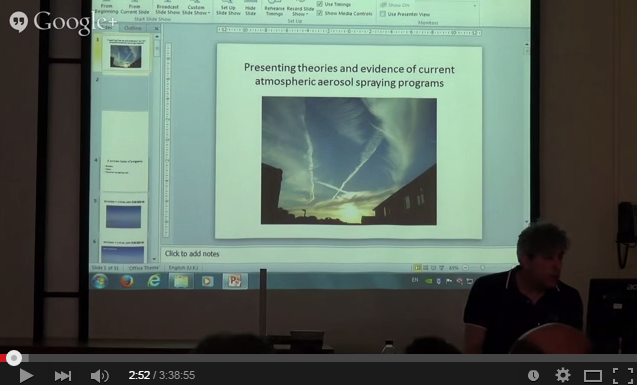
OK, I’ll just flip through most of them… We see a lot of similarities, basically, between the things that we see and the predicted things that we are supposed to see with the proposed programmes as described by many of the world’s leading scientists. And we also see similarities in the equipment proposed and the equipment that we have discovered exists on aircraft currently. Airbus have stated categorically in writing, and a recorded telephone conversation to us, their planes, their A320s do not leave the factory with any pylon pipes, OK.

Essentially, planes never used to make clouds, really. That should be end of story. Sadly it’s not, so we find ourselves in a quagmire of trying to explain all sorts of things to scientists that we know nothing about. And I likened it to entering the Vatican and telling them God doesn’t exist. You know, it’s a difficult situation but we are getting there.
I’m going to crack on with the three primary programmes that I’ve identified.

Persistent spreading trails, you know, anyone who doubts… basically anyone who’s trying to [inaudible] climate engineering knows all about persistent spreading trails and that’s pretty much what most people talk about but there are two other basic programmes. We’ve got smokers and hazers, which I’ll focus on today.
Smokers, we saw the video - what’s going on? The only explanation we can think of, really, is that the three-pipe aerosol delivery systems, which are generally used for the persistent spreading trails, are being used to pump diesel into the atmosphere, or some kind of fossil fuel. Why on Earth would they do that? Simple: 400 parts per million. Fear. It’s what they’re trying to do, they’re trying to raise CO2, they’re pumping loads of smoke into the atmosphere. It has detrimental health effects, I don’t have time to go into now, but essentially it’s all about creating a climate emergency, on the back of which they can create a state of emergency, on the back of which they can do anything they want. I won’t go into who “they” are. You’ve seen the video.
This could be - we don’t know, we’ve not managed to get any samples, we’ve not managed to do the testing on it - but Greenland ice is covered in black soot. Where’s it coming from? It could be fires, it could not be, but when you see videos of planes pumping fossil fuels into the sky, it makes you wonder.
Second programme: haze. I work in theatres. If you want to create a nice hazy environment, what do you do? You use what’s called a cracked-oil machine. What does it do? It pumps tiny little particles into the air, and all the lights seem nice and fuzzy and beautiful. That’s what our sun looks like on most days these days.

Haze pipes: these are 737-800s. This is not my image - all the other images are all mine. This was taken from the internet, a 737-800, it’s a different system. Firstly the containers are on the rear of the aircraft, not the front, and it’s a single pipe - you don’t need to mix anything for this stuff. They’re basically tiny little plastic fibres, and they fill up skies on most days. This is probably the hardest bit for anyone to accept: to most people, they would say “This is what our skies used to look like, this is a beautiful natural sky.”

Wrong! OK, this is what I call “induced cumulus”. Now, if you pump trillions and trillions of tiny little fibres into the atmosphere - and we think they’re around 2 to 20 microns - what’s going to happen? On days of high moisture, they will form cloud, and basically the pattern with which these clouds emerge shows that they’re not really forming naturally, they’re not coming in in great big banks of cloud. What you will see is a particularly hazy sky in the morning, 10 in the morning, by lunchtime you’ll see tiny little wispy bits appearing and getting bigger and bigger and bigger, and suddenly uniformly all over vast areas we have these little fluffy clouds. They’re never very high, and in times of high moisture they get bigger, otherwise if there’s very little moisture you just end up with a hazy filthy mess.
OK, ultimately I can’t prove anything here today, you know. And again, you know, I’m talking to some clever people. But ultimately, I’m hoping that some of you, it may seed this little doubt, and you might take it away and run with it. So, you know, everything here can be explained with: “Oh, it’s probably just…” But you know, you’re scientists - that’s not good enough. Prove me wrong, please.
This is the [inaudible] microscope… this is the … actually, I’ll get onto that in a second, where’s the … you’ve got… uh, this is some of the fibres under an electron...
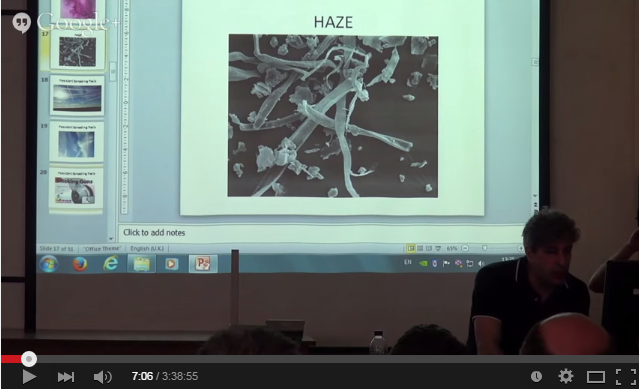
We’ve also done mass spectrometry on them and it seems they’re basically a form of plastic, some kind of polymer plastic, we’re not quite sure yet, we’re trying to get those results out for Berlin. I’m going to do, hopefully try to do a big talk in Berlin where we present the scientific evidence behind this and go a lot deeper into [inaudible].

Where it gets really disturbing is, this stuff collects in your throat. OK, on our tongue we have collections of these little fibres. What they’re doing, we don’t know, we don’t know how they basically assemble, why they’re sticking to our throat. These are desiccated samples, this is what they look when you dry them out, they have like a vascular structure. Again, plastic: if you burn them, they’re plastic.
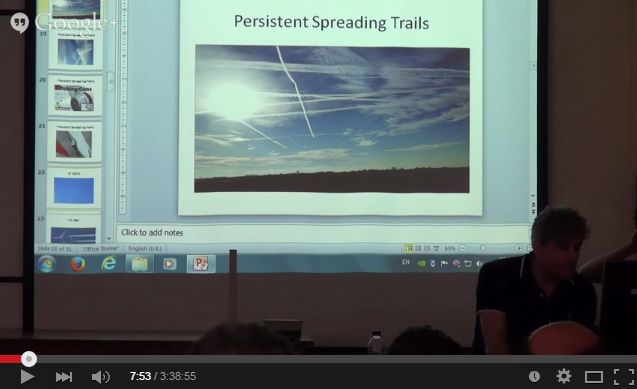
OK, persistent spreading trails, you know, most of you know all about those, but what we’re going to do is prove that they’re coming from aircraft totally. What we’ve been doing is looking at the formation of these trail. This is quite a good image because it shows loads of different trail types:

This stuff here is a particular chemical that’s generally sprayed to induce rainfall. We will see - the Met Office invented a bunch of new clouds a couple of years ago, or in the last two years, and “uncinus” was one of them, along with “halo” and, you know, a load of other stupid names as well that they just invented out of nowhere and put up on their website. And uncinus is one of them. We don’t know what these chemicals are - we can’t go up there and take a sample. We can take atmospheric samples, but them people go, “Oh, it could be from anywhere - it could be, you know, cars or industry or stuff like that,” so you know, we’re in a very difficult position, but we’re getting there.

Then, smoking guns. Airbus A320s, these are the pipes. You can even see, if we zoom in, this is the best image we have so far.

OK, the metalwork’s been cut away, three pipes. Top two, constant stream, the bottom one we believe to be the pulse. OK, the pulse produces little puffs of smoke - when you see these trails spread you have two lines in the trail, you have little puffs underneath, the puffs form the bobby cloud, the bobbly cloud forms a very thin layer, and you know, it goes on and on and on.

O WOW! [note: This stands for "One With, One Without" according to Ian's dossier] Two - three planes, in one sky, all at the same altitude, one with a trail, two without. How do you explain that?

This is another one I’d invite scientists to disprove. No gap. So, we’re talking about two to three metres to drop from 900 degrees Centigrade, the general operating temperature of a jet in cruising speed, and the formation of so-called “ice crystals”. And if you work it out, that’s about 0.2 to 0.4 milliseconds. Is that possible? Minus 57 degrees, from 900? I don’t know, you tell me. It seems suspicious to me.
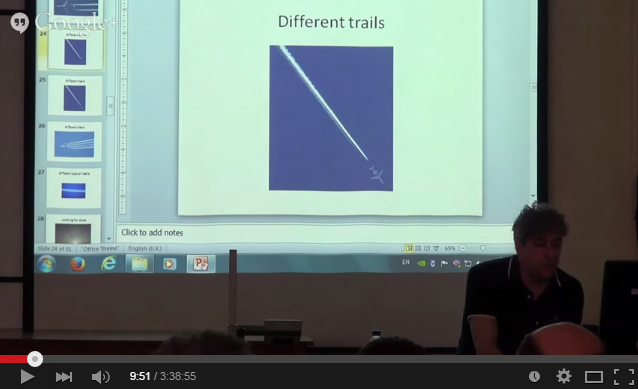
Different trails, one coming from one, one coming from the other - different chemicals obviously, different substances.
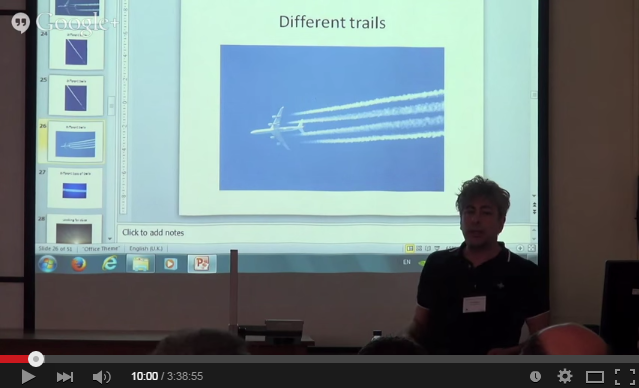
Different trails again. You see, two different trails, from the outside ones to the inside ones. Combination therapy: we often see two jet planes travelling in parallel, right the way across the sky, one will be leaving a short hazy trail the other will be leaving a very thin persistent trail. They seem to mix, they seem to be doing something. We don’t know what, again, we can only point them out.

Various other things, we’re looking for clues, we see patterns in rainfall, in respiratory diseases...

...aircraft patterns, where they fly and in what paths seems to relate very directly to respiratory problems, rainfall, all sorts of things.

This [inaudible] 6.35, 7.41, OK, we counted about a dozen trails there. That’s what planes can do to the sky. If you can’t see all this, you’re being paid too much. That’s my little saying, basically.

New clouds: mammatus is basically persistent trails, in high moisture what they do, they form these little bobbly things...

in high moisture they drop. They don’t actually generally tend to rain, the uncinus seem to cause the rain.
Uh, various other things, aerotoxic syndrome, I haven’t got time to go into, uh, blah blah blah. I’m going to stop there, and go onto questions, because I don’t really want to take up any more time. So again, you know, I do talks on this publicly, and I’m quite willing to come back. My talks are generally three hours with another hour of discussion, so if you really want to know the nuts and bolts of what’s going on and go into depth then I’m quite happy to do it. If not, you’ll have to wait until Berlin, if they let us talk. So, any questions?
QUESTIONS
Questioner 1: Are there any theories about who’s doing it?
IS: Er, yeah, it’s not something I like to go into because it’s very very difficult to prove. But essentially one thing you need to consider is there is no such thing as a national airline any more. All - virtually all airlines, with the exception of some of the UK budget ones and European budget ones, belong to three airline alliances, and they’ve all been amalgamated over the last 20 years, and when you look at the corporate structure above the directorship level, you’re talking global billionaires, basically.
Q1: But why would they do that?
IS: Why? Well, do you know what, why do people rob banks? When you see people robbing banks you don’t go, “Oh, why are they doing that?” You know, you just phone the police.
Q1: [inaudible]
IS: I don’t know. Do you know, I have my own theories but it’s not something I get into, basically. My focus is basically saying, “Look, see that? That shouldn’t be happening, can you do something?” So, yes…?
Chair: There’s a question at the back here
Questioner 2: Yeah, my engineering colleagues here, I've shown them your leaflets and various people have said, oh that sounds very interesting, and a colleague proposed different things they might be. One being that it’s very important, given that the wings of an aircraft are also the fuel tanks, it’s very important that you have ventilation of the various spars of the wings, and the different airlines with different aircraft use different means of ventilating the spars, and these are, according to my colleagues, the spar vents. You know, would that make any difference? [?]
IS: Yeah I’ll answer that. Basically, we spoke to EASA, and they have no information basically. They have no licence for this modification. All aircraft in Europe covered by EASA, any modification, is either a major or minor modification, requires a licence. They have no record of the licence. [talking over Q2] Also Airbus said they’re not original. And we’ve spoken to chief engineers of various airlines and they’ve come up with all sorts of ludicrous excuses about moisture release and hydraulic release, even fuel dump pipes, I mean, dumping fuel into the 900C exhaust? Drag plane! You know, so we can’t prove it yet. We’re basically launching legal action very soon, we’re going to get Airbus in court and we’re gonna make them tell us exactly what’s what. That’s really where we’re going. But we would like some scientific evidence to back all this up as well. Because ultimately we believe that some… at least some of these programmes could be harmful. I can’t say more than that at the moment, I’m not [inaudible, over Q2]... you know, I’m very suspicious.
Chair: Chap at the back, if you’d like to say who you are and [inaudible]?
Questioner 3: Yeah sure, I’m David [inaudible], Cambridge. I just had a question on your three-metre, uh, the three-metre theory behind the…
IS: Yes...
Q3: ..behind the exhaust of the engines. So you’re aware that most Rolls-Royce engines run at about a 92% bypass rate? So...
IS: No, I’ve absolutely no idea what that means. I’m not an engineer.
Q3: Sure, OK, well I think perhaps you might like to ask an aircraft engineer why you get that three-metre separation. Because a Rolls-Royce standard… a Rolls-Royce engine runs at about a 92% bypass rate so essentially what you get is a mixing of the exhaust gases with the minus 50 degree gases as they come through the engines? So essentially you’ve got your standard jet engine going…
IS [interrupting]: But that’s only the case on a turbofan engine, isn’t it?
Q3: But that is a turbofan engine that you’ve put up there, right? OK? They’re all turbofans, so you get mixing of the exhaust, so…
IS: Not all turbofans, but anyway…
Q3: Sorry?
IS: They’re not all turbofans. Some of the others…
Q3: That one, the 800 [?] is a turbofan. The one you put up there is a turbofan...
IS: Well yeah, valid point. I did say that, you know, that’s not something I’ve gone into, right...
[IS and Q3 talk over each other]
Q3: But if you’re going to tell the public that it’s impossible for there to be a three-metre gap…
IS: I’ve not said that.
Q3: But, I mean, that’s what you tried to put forward to us. You shouldn’t need to check with someone who actually knows about this stuff. Similarly with the pipes, right? Ask somebody who put the pipes on the aircraft, rather than…
IS: Well, who put them on, then?
Q3: ...saying, “Oh, we checked with someone and nobody quite knows where they came from.” If you ask an aircraft engineer, they will be able to tell you where the pipes came from. The pipes are there for a reason.
IS: Well, we spoke to one engineer, and he said they’re… it’s not… there’s no such thing as a pylon pipe. OK? Off the record...
Q3: That doesn’t sound like a very…
IS: On the record, basically they say they’re original. Rob Crew. I spoke to Rob Crew, chief engineer at British Airways: “Oh no, they’re original, we haven’t modified our planes.” Airbus claim different. So who’s telling the truth? You know, easyJet, chief engineer, I’ve got it in writing, they’re “hot air vent pipes”. Rolls-Royce said: “We don’t have hot air vent pipes.”
Q3: But they’re [drowned out by IS]
IS: So who’s telling the truth?
Q3: But they’re part of the wings, not the engines, so you don’t go to an engine manufacturer asking why they’ve got vent pipes on the wing.
IS: So you’re telling me one of the chief engineers at Rolls-Royce doesn’t know what he’s talking about?
Q3: Well the chief engineer at Rolls-Royce is designing the engine, not the wing.
IS: Yeah but he should know where all the pipes go.
Chair: OK, let’s move on to the next question.
Questioner 4: [inaudible] I have a question, sir. For my job I’m an atmospheric physicist, who has done a lot of work on contrails. And I am very confident I can explain all the pictures you have shown me today as just contrails. So, do you think I am part of that conspiracy?
IS: No, because I don’t know what you’ve got to say, but I’d like to talk to you, yeah. I’d like to hear your explanations. What do you consider the minimum conditions for contrails in terms of altitude and temperature? Because the Met Office used to say, minus 57 degrees and 37,000 feet, which is the average…
Q4: [inaudible] figures, that is not right... [IS begins to interrupt and is silenced by chair]. It is variable…
IS: In a temperate zone, that is what they said.
Q4: That was approximate [?], anyway. I’m confident… Do you think [inaudible] scientists… I mean, what is it, a hundred scientists like me, who work on contrails, and [inaudible], so do you think we’re totally stupid, or do you think we are part of some conspiracy?
IS: No, I don’t judge anyone individually. As I said, my mission is to say: “Look, actually to me that doesn’t make sense,” so I’m presenting my evidence, and if you want to come and talk to me and teach me something about that then you’re welcome. Basically, when I see a plane at 16,000 feet leaving a persistent trail on a warm sunny day, to me that doesn’t make sense. When you look at radiosonde data, you realise that you can’t get those sort of temperatures, especially on a summer’s day, to produce those kinds of trails. [Q4 trying to interject] OK, and then you see another plane next to it, not leaving anything, to me that’s suspicious. Come and talk to me, please.
Chair: We’ve got to press on with the next speaker now...
[ENDS]





























